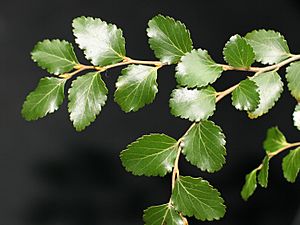Silver beech facts for kids
Quick facts for kids Silver beech |
|
|---|---|
 |
|
| Scientific classification | |
| Genus: |
Nothofagus
|
| Species: |
menziesii
|
| Synonyms | |
|
Lophozonia menziesii |
|
The Nothofagus menziesii, commonly known as silver beech, is a type of tree that belongs to the southern beech family. It is special because it grows only in New Zealand. Its name, silver beech, likely comes from its bark, which often looks whitish, especially when the tree is young.
You can find silver beech trees in the North Island of New Zealand, starting from Thames and going south (but not around Mount Taranaki/Egmont). They also grow all over the South Island. This forest tree can grow very tall, up to 30 meters (about 100 feet). Its trunk can be quite wide, up to 2 meters (about 6.5 feet) across, and often has a wide, strong base called a buttress.
The leaves of the silver beech are small, thick, and almost round. They are usually 6 to 15 millimeters long and 5 to 15 millimeters wide. They have rounded teeth, often in pairs. Sometimes, you can find tiny, hairy pockets called domatia on the underside of the leaves. The Māori name for this tree is tāwhai. Silver beech trees can grow from low areas all the way up into the mountains. In 2013, scientists suggested changing its scientific name to Lophozonia menziesii.
Where Silver Beech Grows
Silver beech is one of the most common beech trees in New Zealand. It grows in cold, wet forests. You can find it from the Bay of Plenty in the North Island down to the very bottom of the South Island. However, you won't find any beech trees on Stewart Island.
In the South Island, silver beech can grow from sea level up to the treeline (the highest point where trees can grow). In the North Island, these trees mostly grow in mountain forests and areas just below the treeline. Silver beech forests are very common in the wetter parts of the South Island, especially in Fiordland and Southland.
Silver beech trees often grow better than other beech species in very wet and cold places. This is because they are good at handling low nutrients in the soil. They also do well in shady areas and prefer cooler temperatures for making their food (photosynthesis). You can often see large forests made only of silver beech trees high up in the mountains, between 500 meters and the treeline. They also grow in valleys, especially inland valleys where there is a lot of moisture in the air and soil.
Sometimes, there are areas in New Zealand that seem perfect for southern beech trees, but no beeches grow there. These areas are called 'beech gaps'. Scientists have different ideas about why these gaps exist. Some think it's because of ice ages, volcanic eruptions, or long periods of dry weather. Another idea is that Māori people might have caused droughts by lighting forest fires before Europeans arrived. The biggest beech gap is in central Westland in the South Island. This gap separates two areas where many unique plants and animals live: Otago-Southland and northwest Nelson.
Uses of Silver Beech Wood and Bark
The wood from the silver beech tree is very hard. People use it to make furniture. However, it doesn't last long if it's used outdoors. The bark of the tree contains a black dye. It also has a substance called tannin, which is used to treat leather.
See also
 In Spanish: Haya plateada de Nueva Zelanda para niños
In Spanish: Haya plateada de Nueva Zelanda para niños


